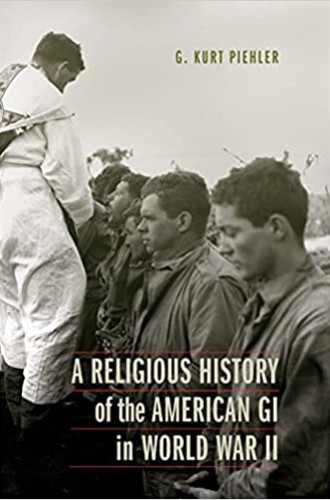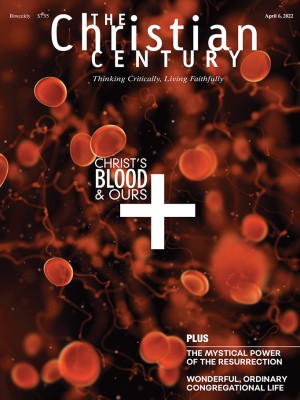American GIs and the chaplains who served them
Kurt Piehler reconstructs the lived religious experience of the World War II battlefield.
In his most recent book, G. Kurt Piehler heaps praise on President Franklin Delano Roosevelt for something we seldom consider: his unwavering commitment to religious freedom and the role this played in helping American troops face the terror of World War II.
To appreciate this insight, we need first to examine the emissaries of FDR’s message: American military chaplains. Because ordained clergy were exempt from conscription, all chaplains were volunteers (or, in the case of Catholic clergy, were volunteered by their superiors). Army chaplains were trained at Harvard; navy chaplains at William and Mary. Upon graduation, they were embedded with US forces for the duration of the war. As a result, many chaplains faced mortal combat—even though they were strictly forbidden from carrying weapons to defend themselves.
Read our latest issue or browse back issues.
A Religious History of the American GI in World War II details not only how American chaplains provided spiritual sustenance to the troops but also how they bravely assisted medical personnel, evacuated troops with battle wounds, ministered to the injured, and presided over the funerals of those who never made it home. Some chaplains were captured and continued to minister as best they could to their fellow POWs in prison. Perhaps as many as 100 chaplains were killed.
These myriad demands constantly overwhelmed chaplains during the four years the United States was in the war. There were never enough of them to minister effectively to the millions of men and women in uniform. Yet, Piehler notes, the military steadfastly refused to allow ordained female clergy to serve as chaplains—not even stateside and out of harm’s way, which would have freed more male chaplains to serve overseas. Nor were Muslims or Native American faiths allowed to provide their clergy to serve as chaplains, and only late in the war were Buddhists allowed to.
Piehler also devotes considerable ink to the ugly stain of Jim Crow. Along with segregating essentially all units by race, the military set educational requirements for its uniformed clergy that excluded many Black pastors from serving as chaplains. In fact, the navy—where segregation lingered far longer than in the army—commissioned only two Black chaplains during the entire war. This two-pronged discrimination meant that large swaths of Black troops often found themselves without meaningful access to any chaplain at all.
Piehler’s comprehensive study is by no means confined to chaplains. He also examines the faith of those to whom they ministered: GIs desperate to feel a connection to the lives they left behind, especially in moments of terror. There is a striking tenderness in Piehler's use of the letters and oral histories of individual GIs to demonstrate their struggle when faith seemed to fail them.
I heartily and unconditionally recommend A Religious History of the American GI in World War II as the best book available on World War II’s chaplain service and the challenges US forces faced in trying to maintain their faith. While Ronit Stahl’s Enlisting Faith (2017) is a superb chronicle of US military chaplains in the 20th century, only two of its chapters are devoted to World War II. Moreover, as Stahl’s book focuses on chaplains, the experience of the troops receives understandably scant coverage.
Likewise, while Michael Snape’s God and Uncle Sam (2015) competently addresses many of the same topics Piehler does, it lacks Piehler’s careful use of denominational records and unpublished soldiers’ narratives. Snape also misses Piehler’s crucial point about the pivotal role FDR played in ensuring US troops would enjoy the free exercise of religion during the war.
Ever since 1791, when the First Amendment was added to the Constitution, Americans have been guaranteed freedom of religion. America’s faithful have largely accepted this restriction on the dominance of a single faith tradition, if grudgingly at times. FDR’s attitude was not one of grudging acceptance. Piehler details how he consciously erected a structure of religious tolerance and pluralism to guarantee everyone in uniform the right to exercise their faith. FDR’s intent is evident in the government-sponsored films made by Frank Capra, especially Prelude to War, which opens with quotations from Moses, Confucius, Muhammad, and Jesus.
Nor was FDR’s devotion to religious pluralism a mere pragmatic improvisation thrust upon him after Pearl Harbor. Rather, as Piehler notes, it was a central concern for him from the time he first took office in 1933. FDR frequently hosted representatives of Reform Judaism, Roman Catholicism, and mainline Protestant sects. In a national radio address in 1936 in support of the interfaith National Conference of Christians and Jews, he asserted, “There are honest differences of religious belief among the citizens of your town, as there are among citizens of mine. . . . And it is well for us to remember that this America of ours is the product of no single race or creed or class.”
As the Nazis’ power grew, FDR strengthened this message, maintaining that the “defense of religion, of democracy, and of good faith among nations is all the same fight. To save one, we must now make up our minds to save all.” FDR’s framing of the global crisis in this way clearly influenced those who served in the war—a fact that is evident in social science surveys given to military inductees. These GIs overwhelmingly “expressed strong sentiments regarding the religious nature of this conflict and the threat posed not only to Jews but to all religions if the Nazis conquered America.”
As America began its military buildup in anticipation of entering the war, FDR had chapels erected at government expense in army training camps. This was a dramatic break with the past, when chapels had been built largely with private funds. He also had the army print three different versions of the Bible—Jewish, Catholic, and Protestant—for soldiers and airmen. (The navy, always more resistant to change, refused to spend funds on chapels and Bibles, relying instead on such private sources as the American Bible Society.) And, at FDR’s insistence, clergy were selected in proportion to the demographic makeup of the troops they would serve. This led to a dramatic increase in the number of Catholic and Jewish chaplains.
By design, the chaplains’ training at both Harvard and William and Mary forced them to engage with clergy from other faith traditions. In fact, “Jews, Catholics, and Protestants were thrown together as roommates” so that “misconceptions and falsehoods could be confronted and corrected.” Once embedded with their units, chaplains were required to file monthly reports stating how they had served the men in their units who were Protestants, Jews, and Catholics because the “expectation was that chaplains must accept the religious pluralism of the armed forces and see to the spiritual needs of individuals outside their own traditions.”
Importantly, once embedded in their units, chaplains were accorded the right to maintain complete privacy in their communications with those serving in their units—a privilege not given to physicians. This assurance of privacy strengthened the bonds between chaplains and those they served.
It was not always easy for chaplains to meet the spiritual needs of American troops in a pluralistic faith community. Some faced severe challenges to their own beliefs and practices. Christian Science chaplains assisted medical personnel in tending those injured in battle, teetotaling Protestant chaplains were often tasked with handing out beer to their troops, and Catholic chaplains blanched at the military’s use of Freudian psychology in psychiatric examinations. There were frequent complaints from all quarters that chaplains of other faiths had been poaching converts.
Others experienced difficulties with worship. Reform Jewish chaplains often had limited facility with the Hebrew spoken by their Orthodox colleagues, and many fundamentalist Christians and Orthodox Jews could never get used to the ecumenism on display during worship services. Also, chaplains served under superior officers, some of whom were hostile to religion.
Still, Piehler makes clear that these structural impediments and petty grievances were far outweighed by the bravery with which most chaplains served. Importantly, these chaplains did so not by abandoning their core religious convictions but instead by setting those convictions aside to help the Allies defeat the tyrannical Axis regimes they saw as existential threats to the free exercise of their faith.
This was, in fact, the attitude that motivated the entire World War II generation. Piehler emphasizes that this shared fear of the consequences of failure likewise led US troops of various faith traditions to seek spiritual guidance from clergy they likely never would have encountered before the war. Chaplains, in turn, offered spiritual advice to these troops regardless of their religious convictions.
These chaplains succeeded in this work far more often than they failed—which, of course, was what FDR intended. As he said in 1944, “We on our side have made freedom of religion one of the principles for which we are fighting this war.”
In the book’s acknowledgments, Piehler expresses a hope that his children “will live in an America that continues to strive to further the vision of religious pluralism espoused by Franklin D. Roosevelt.” However much we may share Piehler’s hope, we can’t ignore the reality that America seems headed in the opposite direction. Something has happened in the intervening 80 years that repudiates the conviction held by those Americans fighting World War II—the belief that we are all in this together and need to exercise tolerance toward those who hold different religious views from our own.
I suggest we take a page from the World War II generation. Rather than making enemies of our fellow citizens simply because they fail to share our beliefs, we should embrace what led our parents and grandparents (and their chaplains) to serve so bravely in World War II: FDR’s clear message that there is no place for intolerance and bigotry in a free society, and there never will be.







